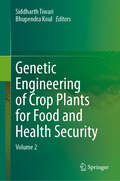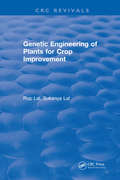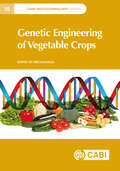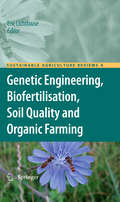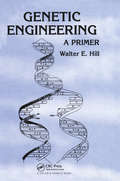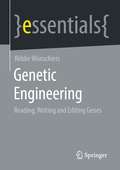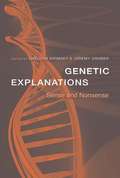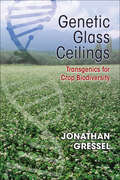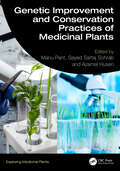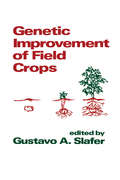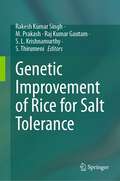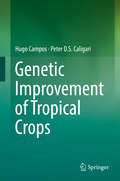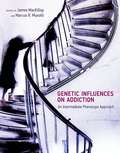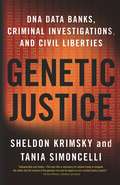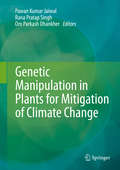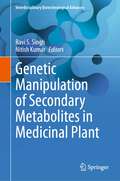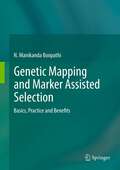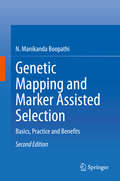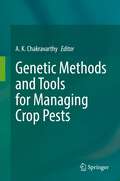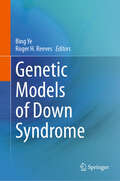- Table View
- List View
Genetic Engineering of Crop Plants for Food and Health Security: Volume 2
by Siddharth Tiwari Bhupendra KoulThis edited volume presents recent advancements in genetic transformation and genome editing, offering a comprehensive understanding of their applications for creating more sustainable crops. These innovations are revolutionizing crop development, enhancing yields, and mitigating environmental challenges.The demand for sustainable crop production, driven by a growing global population and mounting environmental challenges, has never been more pressing. Genetic transformation and genome editing techniques offer precise and targeted ways to enhance crop traits, increase yields, and reduce the need for chemical inputs. The book traces the evolution of these technologies, from the early days of genetic modification to the current era of CRISPR-based genome editing. It covers cutting-edge technologies, from CRISPR-Cas9 to advanced gene editing techniques, while discussing the current scenario and future prospects of GM crops developed either by transgenic or genome editing approaches. The book explores the ethical and regulatory aspects surrounding genetic transformation, providing a complete perspective on this evolving domain.It is an essential read for researchers, students, and professionals in the fields of agriculture, plant sciences, biotechnology, agronomy, as well as policymakers.
Genetic Engineering of Plants for Crop Improvement
by Rup LalGenetic Engineering of Plants for Crop Improvement discusses current genetic engineering methods for plants and addresses the commercial opportunities for transgenic plants. Topics covered include Agrobacterium-mediated transformations, the use of electroporation, PEG-mediated transformation, microinjection, the microprojectile bombardment method, and the electrical discharge particle acceleration method. A concise account of the resistance of transgenic plants to insect attack, viral infection, and herbicides has also been provided. Possibilities for genetic manipulation for proteins that have superior nutritional properties are discussed, and a brief account of tests confirming the safety and commercial validity of transgenic plants is included. A valuable source of information for researchers and students in plant biotechnology, plant gene manipulation, molecular biology, and all areas of the life sciences.
Genetic Engineering of Vegetable Crops (CABI Biotechnology Series)
by Pritam KaliaConventional plant breeding alone can no longer sustain the rising global demand for food. Genetic engineering technology makes it possible to develop new crop varieties with improved yield performance, specific quality attributes (external and internal in vegetable crops), resistance to diseases and insect pests, and environmental stresses. Genetic engineering technology for developing GM crops is complementary to genome editing and other breeding technologies. In addition to food requirements, transgenic crops have the possibility to carry edible vaccines and therapeutic proteins, to help combat human disease and malnutrition. This book reviews the importance and safety of transgenic vegetable crops and covers a wide variety of crops and different technologies. It includes: Genetic engineering in tomato, eggplant, peppers, amaranth, cauliflower, carrot, cucurbits, potato, tropical tubers and melons. Transgenic resistance to viral diseases. Embryogenic cell suspension culture. Genome editing and CRISPR/Cas9. Molecular techniques for biofortification. RNAi strategies for vegetable crop improvement. Designing futuristic vegetable crop varieties. This book is suitable for researchers in horticulture, plant science, and agricultural biotechnology as well as practitioners in vegetable breeding and seed production.
Genetic Engineering, Biofertilisation, Soil Quality and Organic Farming
by Eric LichtfouseSustainable agriculture is a rapidly growing field aiming at producing food and energy in a sustainable way for humans and their children. Sustainable agriculture is a discipline that addresses current issues such as climate change, increasing food and fuel prices, poor-nation starvation, rich-nation obesity, water pollution, soil erosion, fertility loss, pest control, and biodiversity depletion. Novel, environmentally-friendly solutions are proposed based on integrated knowledge from sciences as diverse as agronomy, soil science, molecular biology, chemistry, toxicology, ecology, economy, and social sciences. Indeed, sustainable agriculture decipher mechanisms of processes that occur from the molecular level to the farming system to the global level at time scales ranging from seconds to centuries. For that, scientists use the system approach that involves studying components and interactions of a whole system to address scientific, economic and social issues. In that respect, sustainable agriculture is not a classical, narrow science. Instead of solving problems using the classical painkiller approach that treats only negative impacts, sustainable agriculture treats problem sources. Because most actual society issues are now intertwined, global, and fast-developing, sustainable agriculture will bring solutions to build a safer world. This book series gathers review articles that analyze current agricultural issues and knowledge, then propose alternative solutions. It will therefore help all scientists, decision-makers, professors, farmers and politicians who wish to build a safe agriculture, energy and food system for future generations.
Genetic Engineering: A Primer
by Walter E. HillGenetic Engineering: A Primer presents the growing field of biotechnology to non-science majors and other general interest readers. The author examines the natural forces that change genetic information and the ways in which scientists have learned to engineer these genetic changes. With a wealth of information flooding the popular press, including
Genetic Engineering: Reading, Writing and Editing Genes (essentials)
by Röbbe WünschiersThis essential should serve as an introduction for a contemporary public discussion on genetic engineering. Genetic engineering affects us all in many areas and we must dare to think more colorful and further. In fact, the complete genetic material of viruses and bacteria can already be chemically produced and "brought to life". With genetic surgery, medicine is at a crossroads: do we want to treat hereditary diseases or "repair" them genetically? And the analysis of thousands of human genetic material reveals information that is related to complex diseases, but also to characteristics such as intelligence. How should we use this knowledge? The question is hardly whether we want genetic engineering, but rather how we use it.This Springer essential is a translation of the original German 1st edition essentials, Gentechnik by Röbbe Wünschiers, published by The Editor(s) (if applicable) and The Author(s), under exclusive license to Springer Fachmedien Wiesbaden GmbH, part of Springer Nature in 2019. The translation was done with the help of artificial intelligence (machine translation by the service DeepL.com). A subsequent human revision was done primarily in terms of content, so that the book will read stylistically differently from a conventional translation. Springer Nature works continuously to further the development of tools for the production of books and on the related technologies to support the authors.
Genetic Enhancement in Major Food Legumes: Advances in Major Food Legumes
by Rajeev K. Varshney Rachit K. Saxena Kul Bhushan SaxenaThe protein molecule is the basic building block of every living entity. Its deficiency leads to restricted growth and development of individuals. Globally, such malnutrition is on the rise due to various reasons such as rapid population growth, stagnation of productivity, and ever-rising costs. Millions of people, especially in developing and under-developed countries, suffer from protein malnutrition and the only possible solution is to encourage farmers to grow high-protein food legume crops in their fields for domestic consumption. This, however, could be possible if farmers are provided with new cultivars with high yield, and resistance to major insects, diseases, and key abiotic stresses. The major food legume crops are chickpea, cowpea, common bean, groundnut, lentil, pigeonpea, and soybean. Predominantly, the legume crops are grown under a subsistence level and, therefore, in comparison to cereals and horticultural crops their productivity is low and highly variable. The crop breeders around the globe are engaged in breeding suitable cultivars for harsh and changing environments but success has been limited and not up to needs.With the recent development of new technologies in plant sciences, efforts are being made to help under-privileged farmers through breeding new cultivars which will produce more protein per unit of land area. In this book, the contributors analyze the constraints, review new technologies, and propose a future course of crop breeding programs in seven cold and warm season legume crops.
Genetic Explanations
by Sheldon Krimsky Jeremy GruberNo longer viewed by scientists as the cell’s fixed master molecule, DNA is a dynamic script that is ad-libbed at each stage of development. What our parents hand down to us is just the beginning. Genetic Explanations urges us to replace our faith in genetic determinism with scientific knowledge about genetic plasticity and epigenetic inheritance.
Genetic Glass Ceilings: Transgenics for Crop Biodiversity
by Jonathan GresselAs the world’s population rises to an expected ten billion in the next few generations, the challenges of feeding humanity and maintaining an ecological balance will dramatically increase. Today we rely on just four crops for 80 percent of all consumed calories: wheat, rice, corn, and soybeans. Indeed, reliance on these four crops may also mean we are one global plant disease outbreak away from major famine. In this revolutionary and controversial book, Jonathan Gressel argues that alternative plant crops lack the genetic diversity necessary for wider domestication and that even the Big Four have reached a "genetic glass ceiling": no matter how much they are bred, there is simply not enough genetic diversity available to significantly improve their agricultural value. Gressel points the way through the glass ceiling by advocating transgenics—a technique where genes from one species are transferred to another. He maintains that with simple safeguards the technique is a safe solution to the genetic glass ceiling conundrum. Analyzing alternative crops—including palm oil, papaya, buckwheat, tef, and sorghum—Gressel demonstrates how gene manipulation could enhance their potential for widespread domestication and reduce our dependency on the Big Four. He also describes a number of ecological benefits that could be derived with the aid of transgenics. A compelling synthesis of ideas from agronomy, medicine, breeding, physiology, population genetics, molecular biology, and biotechnology, Genetic Glass Ceilings presents transgenics as an inevitable and desperately necessary approach to securing and diversifying the world's food supply.
Genetic Improvement and Conservation Practices of Medicinal Plants (Exploring Medicinal Plants)
by Azamal Husen Manu Pant Sayed Sartaj SohrabThis book explores the most recent advances in medicinal plant conservation and improvement through genetic transformation. It presents a compendium of topics related to conservation for sustainable utilization of important medicinal and aromatic plants, plant tissue culture interventions, genetic engineering tools for plant transformation, and transgenics for improved traits in the medicinally active plant species. Advancements in the areas of medicinal plants’ nuclear and chloroplast engineering, stress tolerance, metabolite production, DNA barcoding, etc. have been carefully intertwined to offer novelty for the readers. The book caters to the interests of plant biologists, biotechnologists, ecologists, chemists, and pharmacologists and will be helpful to researchers, academicians, and students in the areas of medicinal plants’ conservation, propagation and genetic improvement. Salient Features: 1. Provides a detailed and up-to-date account of the role of in vitro methods in the sustainable conservation of medicinally important plants. 2. Serves as a comprehensive guide for different methods of genetic engineering of medicinal plants. 3. Demonstrates application of genetic transformation strategies for improved characters, bioactive production, and stress tolerance in medicinal plant species. 4. Elaborates the conservation and genetic engineering methods for priority medicinal plants. 5. Discusses the application of advanced techniques like bioinformatics, genomics, and DNA banks for medicinal plant conservation and improvement.
Genetic Improvement of Field Crops
by Gustavo A. SlaferOutlining successful breeding techniques to augment the yields of the world's major crops, this reference analyzes the physiological and genetic basis for past and potential future increases in crop yields.;Covering crops with wide differences in morphology, photosynthetic rates, and nitrogen metabolisms, Genetic Improvement of Field Crops: investigates the changes produced by breeders in the physiological attributes affecting wheat grain yield and nitrogen content during the last century; discusses those crop characteristics of oats that have already been altered or might be manipulated through breeding to further increase yield potential; describes several genetic factors responsible for both yield potential and stress resistance in barley; offers insights into the relationship between increases in the yield potential and stress tolerance of corn; examines the evolution of sunflower crop yields and yield stability and estimates the contribution of improved cultivars; evaluates the effects of breeding on tuber characteristics related to the crop growth and yield of the potato; elucidates the possibilities for simultaneous improvement of yield and fiber strength in cotton; and identifies the features to be considered in the development of high yielding varieties of rice for different agricultural systems.;Providing nearly 1600 key literature citations allowing further in-depth study of particular topics, Genetic Improvement of Field Crops is for plant physiologists and breeders, crop and agricultural scientists, agronomists, biochemists, geneticists, biotechnologists, microbiologists, and upper-level undergraduate and graduate students in these disciplines.
Genetic Improvement of Rice for Salt Tolerance
by Rakesh Kumar Singh M. Prakash Raj Kumar Gautam S. L. Krishnamurthy S. ThirumeniThis edited book is a compilation of tangible research findings and actual experiences on various salt tolerant rice breeding programmes, that have been successfully practiced and continuing to do so by research centres in South East Asia, with major emphasis in India, Bangladesh and Philippines. Rice being one of the most important staple crops of the world, its production and productivity have to be kept on increasing so as to feed the burgeoning population. This is a very challenging task in the midst of shrinking resource base and arable lands in the face of climate change. Salt stress is the second major abiotic stress, next only to drought, which greatly affects rice production. To overcome this problem, development of improved salt tolerant rice cultivars coupled with appropriate package of practices, an ecologically sound and socially acceptable strategy should be developed which is well within the reach of marginal farmers. With rapid advances in molecular biology, mechanisms underlying the complexity of the trait are better understood now than before. Selection of appropriate parents, desired mapping populations, precise phenotyping are the key components to underpin the mapping and utilization of reliable QTLs. Understanding genetics of salt tolerance, identifying the robust molecular markers and targeted utilization of available molecular markers form the sound basis to develop the commercial products with more precision and speed. This book covers entire range of topics: starting from biophysical characterization of salt stressed areas in different rice ecologies, conventional and molecular breeding approaches for mapping salt tolerance and subsequent development of improved rice varieties for commercial cultivation and their societal impacts. This book is of interest to scientists, faculty, policy makers and administrators. It also serves as a resource guide to graduate students of agriculture particularly plant breeding, plant physiology, molecularbiology and soil science.
Genetic Improvement of Solanaceous Crops Volume 2: Tomato
by M. K. RazdanPotato is the most significant non-cereal crop. Much attention has been paid to this commercially important crop. The aim of this volume is to capture the recent advances made in improving potatoes using traditional breeding methods as well as genetic engineering technology. The book provides a critical appraisal of the state-of-the-art finding on
Genetic Improvement of Tropical Crops
by Hugo Campos Peter D. S. CaligariThis book provides a fresh, updated perspective of the current status and perspectives in genetic improvement of a diverse array of tropical crops. The first part covers aspects which are relevant across crops, namely how to maximize the use of genetic information through modern bioinformatic approaches and how to use statistics as a tool to sustain increased genetic gains and breeding efficiency. The second part of the book provides an updated view of some seed-propagated crops, such as rice, maize and oil palm, as well as crops propagated through vegetative means such as sweet potato, cassava, banana and sugarcane. Each chapter addresses the main breeding objectives, markets served, current breeding approaches, biotechnology, genetic progress observed, and in addition a glimpse into the future for each of these selected and important tropical crops.
Genetic Influences on Addiction
by James MackillopAlthough there is scientific consensus that genetic factors play a substantial rolein an individual's vulnerability to drug or alcohol addiction, specific genetic variables linked torisk or resilience remain elusive. Understanding how genetic factors contribute to addiction mayrequire focusing on intermediary mechanisms, or intermediate phenotypes, that connect geneticvariation and risk for addiction. This book offers a comprehensive review of thismechanistic-centered approach and the most promising intermediate phenotypes identified in empiricalresearch. The contributors first consider the most established findings in thefield, including variability in drug metabolism, brain electrophysiological profiles, and subjectivereactions to direct drug effects; they go on to review highly promising areas such as expectancies,attentional processing, and behavioral economic variables; and finally, they investigate moreexploratory approaches, including the differential susceptibility hypothesis and epigeneticmodifications. Taken together, the chapters offer a macro-level testing of the hypothesis that thesealternative, mechanistic phenotypes can advance the understanding of genetic influences onaddiction. The book will be of interest to researchers and practitioners in a range of disciplines,including behavioral genetics, psychology, pharmacology, neuroscience, andsociology. Contributors: John Acker, Steven R. H. Beach, Gene H. Brody, Angela D. Bryan, Megan J. Chenoweth, Danielle M. Dick, Eske D. Derks, Mary-Anne Enoch, Meg Gerrard, FrederickX. Gibbons, Thomas E. Gladwin, Mark S. Goldman, Marcus Heilig, Kent E. Hutchison, Hollis C. Karoly,Steven M. Kogan, Man Kit Lei, Susan Luczak, James MacKillop, Renee E. Magnan, Leah M. Mayo, MarcusR. Munafò, Daria Orlowska, Abraham A. Palmer, Danielle Pandika, Clarissa C. Parker, Robert A. Philibert, Lara A. Ray, Richard R. Reich, Ronald L. Simons, Courtney J. Stevens, Rachel E. Thayer,Rachel F. Tyndale, Tamara L. Wall, Reinout W. Wiers, Michael Windle, Harriet de Wit
Genetic Influences on Addiction: An Intermediate Phenotype Approach (The\mit Press Ser.)
by James MacKillopA comprehensive review of research examining intermediary mechanisms to understand the link between genetic variation and addiction liability.Although there is scientific consensus that genetic factors play a substantial role in an individual's vulnerability to drug or alcohol addiction, specific genetic variables linked to risk or resilience remain elusive. Understanding how genetic factors contribute to addiction may require focusing on intermediary mechanisms, or intermediate phenotypes, that connect genetic variation and risk for addiction. This book offers a comprehensive review of this mechanistic-centered approach and the most promising intermediate phenotypes identified in empirical research.The contributors first consider the most established findings in the field, including variability in drug metabolism, brain electrophysiological profiles, and subjective reactions to direct drug effects; they go on to review highly promising areas such as expectancies, attentional processing, and behavioral economic variables; and finally, they investigate more exploratory approaches, including the differential susceptibility hypothesis and epigenetic modifications. Taken together, the chapters offer a macro-level testing of the hypothesis that these alternative, mechanistic phenotypes can advance the understanding of genetic influences on addiction. The book will be of interest to researchers and practitioners in a range of disciplines, including behavioral genetics, psychology, pharmacology, neuroscience, and sociology.ContributorsJohn Acker, Steven R.H. Beach, Gene H. Brody, Angela D. Bryan, Megan J. Chenoweth, Danielle M. Dick, Eske D. Derks, Mary-Anne Enoch, Meg Gerrard, Frederick X. Gibbons, Thomas E. Gladwin, Mark S. Goldman, Marcus Heilig, Kent E. Hutchison, Hollis C. Karoly, Steven M. Kogan, Man Kit Lei, Susan Luczak, James MacKillop, Renee E. Magnan, Leah M. Mayo, Marcus R. Munafò, Daria Orlowska, Abraham A. Palmer, Danielle Pandika, Clarissa C. Parker, Robert A. Philibert, Lara A. Ray, Richard R. Reich, Ronald L. Simons, Courtney J. Stevens, Rachel E. Thayer, Rachel F. Tyndale, Tamara L. Wall, Reinout W. Wiers, Michael Windle, Harriet de Wit
Genetic Justice: DNA Data Banks, Criminal Investigations, and Civil Liberties
by Sheldon Krimsky Tania SimoncelliNational DNA databanks were initially established to catalogue the identities of violent criminals and sex offenders. However, since the mid-1990s, forensic DNA databanks have expanded in some states and nations to include all people who have been arrested, regardless of whether they've been charged or convicted of a crime. The public is largely unaware of these changes and the advances in biotechnology and forensic DNA science that have made them possible, but we are beginning to realize that the unfettered collection of DNA profiles from innocent citizens has compromised our basic freedoms and rights. Two prominent advisors on medical ethics, science policy, and civil liberties take a hard look at how the United States, Australia, Japan, and European countries have balanced the use of DNA databanks in criminal justice with the privacy rights of their citizenry. Sheldon Krimsky and Tania Simoncelli analyze the constitutional, ethical, and sociopolitical implications of expanded DNA collection in the United States and compare these findings to trends in other locations. They examine the development of legal precedent for taking DNA from juveniles, searching DNA databases for possible family members of suspects, conducting "DNA dragnets" of large local populations, and the warrantless acquisition by police of so-called abandoned DNA as they search for suspects. Most intriguing, Krimsky and Simoncelli explode the myth that DNA profiling is infallible, which has profound implications for criminal justice.
Genetic Justice: DNA Data Banks, Criminal Investigations, and Civil Liberties
by Sheldon Krimsky Tania SimoncelliNational DNA databanks were initially established to catalogue the identities of violent criminals and sex offenders. However, since the mid-1990s, forensic DNA databanks have in some cases expanded to include people merely arrested, regardless of whether they've been charged or convicted of a crime. The public is largely unaware of these changes and the advances that biotechnology and forensic DNA science have made possible. Yet many citizens are beginning to realize that the unfettered collection of DNA profiles might compromise our basic freedoms and rights.Two leading authors on medical ethics, science policy, and civil liberties take a hard look at how the United States has balanced the use of DNA technology, particularly the use of DNA databanks in criminal justice, with the privacy rights of its citizenry. Krimsky and Simoncelli analyze the constitutional, ethical, and sociopolitical implications of expanded DNA collection in the United States and compare these findings to trends in the United Kingdom, Japan, Australia, Germany, and Italy. They explore many controversial topics, including the legal precedent for taking DNA from juveniles, the search for possible family members of suspects in DNA databases, the launch of "DNA dragnets" among local populations, and the warrantless acquisition by police of so-called abandoned DNA in the search for suspects. Most intriguing, Krimsky and Simoncelli explode the myth that DNA profiling is infallible, which has profound implications for criminal justice.
Genetic Manipulation in Plants for Mitigation of Climate Change
by Om Parkash Dhankher Pawan Kumar Jaiwal Rana Pratap SinghThis book presents a detailed overview and critical evaluation of the state of the art and latest approaches in genetic manipulation studies on plants to mitigate the impact of climate change on growth and productivity. Each chapter has been written by experts in plant-stress biology and highlights the involvement of a variety of genes/pathways and their regulation in abiotic stress, recent advances in molecular breeding (identification of tightly liked markers, QTLs/genes), transgenesis (introduction of exogenous genes or changing the expression of endogenous stress- responsive genes) and genomics approaches that have made it easier to identify and isolate several key genes involved in abiotic stress such as drought, water lodging/flooding, extreme temperatures, salinity and heavy-metal toxicity. Food and nutritional security has emerged as a major global challenge due to expanding populations, and cultivated areas becoming less productive as a result of extreme climatic changes adversely affecting the quantity and quality of plants. Hence, there is an urgent need to develop crop varieties resilient to abiotic stress to ensure food security and combat increased input costs, low yields and the marginalization of land. The role of GM crops in poverty alleviation, nutrition and health in developing countries and their feasibility in times of climate change are also discussed. Recent advances in gene technologies have shown t he potential for faster, more targeted crop improvements by transferring genes across the sexual barriers. The book is a valuable resource for scientists, researchers, students, planners and industrialists working in the area of biotechnology, plant agriculture, agronomy, horticulture, plant physiology, molecular biology, plant sciences and environmental sciences.
Genetic Manipulation of Secondary Metabolites in Medicinal Plant (Interdisciplinary Biotechnological Advances)
by Nitish Kumar Ravi S. SinghThis book provides a comprehensive introduction and review of state-of-the-art biotechnological tools in enhancement of bioactive compounds in medicinal and aromatic plants. Plant bioactive compounds are plant-based natural products that display a variety of pharmacological applications. These bioactive compounds are important as medicines, pigments, flavorings and drugs because most of the pharmaceutical industries are highly dependent on medicinal plants and their extraction. The book introduces a systematic overview of state-of-the-art biotechnological techniques such as Omics, Crisper /Cas9 and RNAi to enhance the plant bioactive contents as well as enlists various in vitro techniques, hairy root culture and transgenic technology to enhance plant bioactive contents using plant tissue culture approaches. The book also provides an overview of the role of induced mutation, biotic and abiotic stress to increase the bioactive contents in plants and discusses the significant role of endophytes to enhance the contents of plant bioactive compound. The book also opens discussions related to standard operating procedures using hydroponics system of cultivation for significant enhancement of bioactive compound(s) and much more. This book serves as an excellent reference book for the researchers working in the field of plant secondary metabolites and pharmaceutical industries at global level.
Genetic Mapping and Marker Assisted Selection: Basics, Practice and Benefits
by N Manikanda BoopathiGenetic mapping and marker assisted selection (MAS) is considered as one of the major tools in genetic improvement of crop plants in this genomics era. This book describes basics in linkage mapping, step-by-step procedure to perform MAS, achievements made so far in different crops, and limitations and prospects of MAS in plant breeding. It summarizes all this in a simple but comprehensive mode using suitable examples so as to explain the concept and its historical developments. To summarize, this book describes technologies for identification of genes of interest through genetic mapping, recaps the major applications of MAS to plant breeding; lists examples in which MAS is being applied to various breeding programs, and emphasizes the various difficulties that limit the application of MAS in plant breeding, providing possible solutions to overcome these difficulties, and finally tries to illustrate the future prospects. This book would be a valuable guide to the under-graduates and post-graduates of agricultural universities and institutes that are interested and/or involved in genetic improvement of crop plants using modern tools. Bibliography listed in this book constitutes two parts: literature cited and further reading. Literature cited contains references cited in the text and further information on the given concept/technique can be obtained from these references. Further reading provides a list of suggested readings for in-depth coverage of the topics.
Genetic Mapping and Marker Assisted Selection: Basics, Practice and Benefits
by N. Manikanda BoopathiThe first edition of this book, Genetic Mapping and Marker Assisted Selection: Basics, Practice and Benefits, was widely appreciated as the first of its kind on this topic and has been listed as a reference work in several agricultural universities’ curricula. A great deal has happened over the last five years, making it high time to incorporate recent developments in genetic mapping and report on novel strategies in marker assisted selection in crop plants as a second edition. This book addresses a range of topics, including: new marker types and their genotyping methods based on high-throughput technologies, advances in genomics and their role in new marker development, improvements in genetic mapping strategies and software updates, developments in phenomics and their applications in QTL mapping, and how to incorporate these developments and advances in marker assisted selection in crop plants. Similar to the first edition, each technique and method is explained using a step-by-step method, allowing the book to serve as a self-study guide for scholars whose work involves the genetic improvement of crop plants for any trait of interest, particularly for biotic and abiotic stress resistance.In addition, the book offers a valuable guide for undergraduate and graduate students at agricultural universities and institutes that are interested and/or involved in the genetic improvement of crop plants using modern tools. In addition, the bibliography includes a list of suggested works for pursuing further research on the topics covered.
Genetic Mapping in Experimental Populations
by J.W. Van Ooijen J. JansenGenetic linkage maps are an increasingly important tool in both fundamental and applied research, enabling the study and deployment of genes that determine important biological traits. This concise introduction to genetic mapping in species with disomic inheritance enables life science graduate students and researchers to use mapping software to produce more reliable results. After a brief refresher on meiosis and genetic recombination, the steps in the map construction procedure are described, with explanations of the computations involved. The emphasis throughout is on the practical application of the methods described; detailed mathematical formulae are avoided and exercises are included to help readers consolidate their understanding. A chapter on recognising and solving problems provides valuable guidance for dealing with real-life situations. An extensive chapter dedicated to the more complex situation of outbreeding species offers a unique insight into the approach required for many economically important and model species, both plants and animals.
Genetic Methods and Tools for Managing Crop Pests
by A. K. ChakravarthyThis contributed volume aims at bringing together all the genetic engineering tools for managing various types of crop pests. The main focus of this book is to explore the application of these tools in pest management. Major pest groups covered in this book are insects, mites and nematodes.The first section covers all major genetic tools and molecular approaches. The second section deals with genetic tools for of beneficial containing three chapters involving honey bees, silkworms and natural enemies. Next section deals with genetic interactions against pests in diverse geographical regions with special focus on Africa, Vietnam and Sri Lanka. Sections four and five addresses diverse aspects as management of pests, genetic behavior, gene expression, plasticity, pathways and interactions and options for mitigation of pests.It serves as a useful resource for professionals in the fields of entomology, agronomy, horticulture, ecology, and environmental sciences, as well as to agricultural producers and plant biotechnologists.
Genetic Models of Down Syndrome
by Bing Ye Roger H. ReevesDown syndrome is a textbook example of a chromosomal disorder and is common, occurring in 1 in 700 live births in the US. While there are many books previously published on the genetics of Down syndrome, and many studies in diverse species, this is the first book of its kind on the research models for Down syndrome that covers animal models. This book offers an in-depth introduction and discussion of the genetic models of down syndrome across diverse species, including rodents, zebrafish, drosophila, and human organoids. Authors use a cross-cutting approach to compare the strengths and weaknesses of each model system, explore how to use model organisms to study human diseases, and capture the status of the field. This book is a useful resource for biomedical researchers and students interested in using model systems to study Down syndrome and learn about Down syndrome and other chromosomal disorders.
